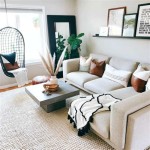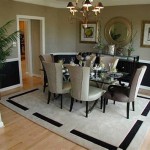Ideas to Decorate a Small Living Room with Dining Area
Designing a functional and aesthetically pleasing living room with a dedicated dining area within a limited space presents a unique set of challenges. Careful planning, strategic furniture selection, and creative use of space are crucial to maximizing the room's potential. This article explores various ideas and techniques to achieve a cohesive and inviting living and dining area, even in a compact environment.
1. Optimizing Furniture Placement
The foundation of a successful combined living and dining space lies in intelligent furniture arrangement. A well-defined layout prevents the room from feeling cramped and allows for easy movement. Consider the natural flow of the room and the relationship between the windows, doors and the chosen focal point. It is important to determine which area, living or dining, will take precedence in the room. The focal point, such as a television or a window with a view, should be considered first so that furniture can be oriented for best viewing. In tight spaces, consider investing in multi-functional furniture. A sofa that converts into a bed, a coffee table with storage, or a dining table with drop-leaf extensions can significantly enhance the room's versatility. Floating shelves are also a great option.
One effective technique is zoning, where furniture is used to define separate areas. For instance, a sofa can act as a visual divider between the living and dining zones. Placing the sofa with its back towards the dining area creates a clear boundary while still allowing for a sense of openness. A console table or a narrow bookshelf placed behind the sofa further reinforces the division and provides additional storage or display space. Always measure furniture before purchasing to ensure it fits comfortably within the space and allows for comfortable walkways. Avoid overcrowding the room by choosing appropriately scaled furniture that complements the room's dimensions. Consider the dimensions of the room, and leave adequate walking space between furniture so the space is not cramped.
2. Choosing the Right Furniture Pieces
Furniture selection plays a vital role in making the most of a small living-dining room. The goal is to balance functionality with the need to avoid clutter and create a streamlined aesthetic. The dining table is a central consideration. A round or oval table is often a better choice than a rectangular one, as it takes up less visual space and facilitates easier movement around it. A drop-leaf or extendable table provides the flexibility to accommodate a larger number of guests when needed. Consider the scale of seating. For dining chairs, opt for lightweight, stackable designs that can be stored away when not in use. Bench seating, especially built-in benches along a wall, can also save space.
For the living area, choose a compact sofa or a loveseat instead of a full-sized sectional. Consider a sofa with a clean design and minimal embellishments to avoid visual clutter. Armchairs should also be carefully selected to avoid dominating the space. Consider chairs with slender profiles or those that can be tucked partially under a table when not in use, such as a dining-height accent chair. Transparency is valuable in small spaces. Acrylic or glass furniture can make a room feel larger because they let light pass through. Built-in shelving helps to make the space cohesive and reduces the amount of furniture needed. Prioritize furniture pieces that are visually light and have a streamlined design to maintain an open feel.
3. Leveraging Color and Lighting
Color and lighting schemes are important factors when designing any interior space, particularly a small one. Light colors and tones are essential to make a space feel larger and more open. Using a light neutral color palette for walls, furniture, and accents can enhance the sense of spaciousness and reflect natural light. Employing a monochromatic color scheme can create a cohesive and calming atmosphere.
Strategic lighting is essential to make the space feel brighter and more inviting. Layering different light sources, such as overhead lighting, task lighting, and ambient lighting, can create depth and versatility. Install recessed lighting for a clean, modern look. Add table lamps and floor lamps to provide focused illumination and create mood lighting. Consider the use of mirrors to reflect light and visually expand the room. Place mirrors strategically to reflect natural light, such as opposite a window or near a light source. The use of accent lighting from a nearby light fixture can help to define and highlight the dining area.
4. Maximizing Storage Solutions
Storage is a critical consideration when dealing with a small living and dining area. Efficient storage solutions help to keep the room organized and prevent clutter from overwhelming the space. Utilize vertical space by installing floor-to-ceiling shelving to maximize storage capacity without taking up valuable floor space. Built-in shelves or a storage unit provide ample space for books, decorative items, and other essentials.
Incorporate storage into furniture choices. Choose a coffee table with drawers or a lift-top design, or opt for a sofa with built-in storage compartments. Dining benches with hidden storage are an excellent way to conceal items while providing additional seating. Consider using storage ottomans or baskets in the living area, or wall mounted cabinets in the back of the dining area to store items that are needed less frequently. Consider using the space under the dining room table. The use of a sideboard can also improve storage.
5. Incorporating Visual Tricks
Certain visual tricks can make a small space feel significantly larger. Mirrors are a powerful tool for creating the illusion of spaciousness. A large mirror placed on a wall will reflect light and the surrounding elements, effectively doubling the perceived size of the room. Using vertical lines, such as tall curtains or a striped rug, can draw the eye upward, making the ceiling appear higher. This can also be applied by using tall bookshelves or by painting the wall a different color.
Avoid using overly bulky furniture, opting instead for pieces with legs that expose the floor beneath. This creates a sense of airiness and prevents the room from feeling cluttered. The use of wallpaper or artwork with a receding perspective can also add depth to a small room. Consistent use of the same flooring throughout the living and dining area will make the space feel cohesive and continuous, creating a sense of spaciousness that emphasizes the size. Using a rug to anchor furniture helps to define the space.
6. The Importance of Zoning and Flow
Defining distinct zones for the living and dining areas is critical for functionality and aesthetics. The use of a rug can help achieve that. A rug can clearly delineate a living room seating area. A rug is a must-have for a small living room. A rug defines the sitting area, adds warmth, and can be used to add pattern and tie together the color scheme. Rugs are an essential part of a dining area. Consider the size of the rug and the shape of the table. The rug should be large enough that the chair legs stay on the rug when they are pulled out from the table.
Ensuring a good flow between the living and dining areas is equally important. Keep walkways clear and avoid placing furniture in high-traffic areas. Arrange furniture in a way that allows for easy movement between the two zones. Consider the relationship between the living and dining areas. If the dining area is near the kitchen, maintain a clear path for serving food. If the dining area is near the front door, make sure there is easy access. Be mindful of the natural traffic patterns within the room and position furniture accordingly.

15 Best Small Living Room Ideas How To Decorate A

Living Room And Dining Design Ideas Designcafe

Living Room And Dining Design Ideas Designcafe

Стулья стол Living Room Dining Combo Small Rooms Condo

Living Room And Dining Design Ideas Designcafe

Living Room Dining Combo Ideas With Tricks Doğtaş

Living Room Dining Combo Ideas With Tricks Doğtaş

11 Design Ideas For Splendid Small Living Rooms

Living Room Dining Combo Proven Strategies To Nail Space Distribution Small Decor Scandinavian Designs
:max_bytes(150000):strip_icc()/236608877_287634333162970_6363336183903051726_n-63ab3e1976184317bdc51527a780339c.jpg?strip=all)
52 Small Living Room Ideas To Maximize Space And Style







